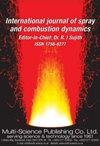Discussing the limitations of unconditional stability indicators in evaluating thermoacoustic quality of burners with flames
IF 2.1
4区 工程技术
Q3 ENGINEERING, MECHANICAL
International Journal of Spray and Combustion Dynamics
Pub Date : 2024-07-23
DOI:10.1177/17568277241265433
引用次数: 0
Abstract
Assessing the thermoacoustic performance of designed combustors, with a focus on the stability quality factor, is crucial. Thermoacoustic instability in combustion appliances arises from intricate interactions among unsteady combustion, heat transfer, and (maybe) acoustic modes within the system. Accurate prediction of system stability requires modeling all components, including the burner with flame. Traditionally, the burner in the presence of combustion is represented as an acoustically (active) two-port block with passive upstream and downstream acoustic terminations. The dispersion relation of the thermoacoustic system is commonly used for anticipating eigen-frequencies and assessing stability. However, practical scenarios often lack specific information about upstream and downstream terminations during development. This raises a critical question: How can the thermoacoustic performance of burners and their associated flames be evaluated without specified acoustics? This article addresses this question by exploring the concept of unconditional stability in a generic two-port thermoacoustic system. The unconditional stability criteria have been used as quality indicators in designing electrical devices. This rich toolbox has been introduced in thermoacoustics. We first scrutinize assumptions underlying two most known unconditional stability-based criteria called [Formula: see text] and [Formula: see text] factors, connecting them to the general thermoacoustic problems. Then, the application of these criteria in assessing the thermoacoustic quality of burners with flames are discussed. This investigation revealed that while they are able to accurately predict the histogram of unstable frequencies and critical frequency bands, their use as reliable indicators to assess thermoacoustic quality in burners are not recommended due to their mathematical limitations and high level of conservatism of these factors.讨论无条件稳定性指标在评估带火焰燃烧器热声质量方面的局限性
评估设计燃烧器的热声性能至关重要,重点是稳定性品质因数。燃烧设备中的热声不稳定性源于系统内不稳定燃烧、热传递和(可能)声学模式之间错综复杂的相互作用。要准确预测系统的稳定性,需要对所有组件进行建模,包括带火焰的燃烧器。传统上,存在燃烧的燃烧器被表示为一个声学(主动)双端口块,具有被动的上游和下游声学终端。热声系统的扩散关系通常用于预测特征频率和评估稳定性。然而,在开发过程中,实际方案往往缺乏有关上下游终端的具体信息。这就提出了一个关键问题:在没有特定声学参数的情况下,如何评估燃烧器及其相关火焰的热声性能?本文通过探讨一般双端口热声系统中的无条件稳定性概念来解决这一问题。无条件稳定性标准已被用作设计电气设备的质量指标。热声学中也引入了这一丰富的工具箱。我们首先仔细研究了两个最著名的基于非条件稳定性的标准,即[公式:见正文]和[公式:见正文]因子的基本假设,并将它们与一般热声问题联系起来。然后,讨论了这些标准在评估带火焰燃烧器热声质量中的应用。调查显示,虽然它们能够准确预测不稳定频率直方图和临界频率带,但由于其数学局限性和这些因素的高度保守性,不建议将它们用作评估燃烧器热声质量的可靠指标。
本文章由计算机程序翻译,如有差异,请以英文原文为准。
求助全文
约1分钟内获得全文
求助全文
来源期刊

International Journal of Spray and Combustion Dynamics
THERMODYNAMICS-ENGINEERING, MECHANICAL
CiteScore
2.20
自引率
12.50%
发文量
21
审稿时长
>12 weeks
期刊介绍:
International Journal of Spray and Combustion Dynamics is a peer-reviewed open access journal on fundamental and applied research in combustion and spray dynamics. Fundamental topics include advances in understanding unsteady combustion, combustion instability and noise, flame-acoustic interaction and its active and passive control, duct acoustics...
 求助内容:
求助内容: 应助结果提醒方式:
应助结果提醒方式:


